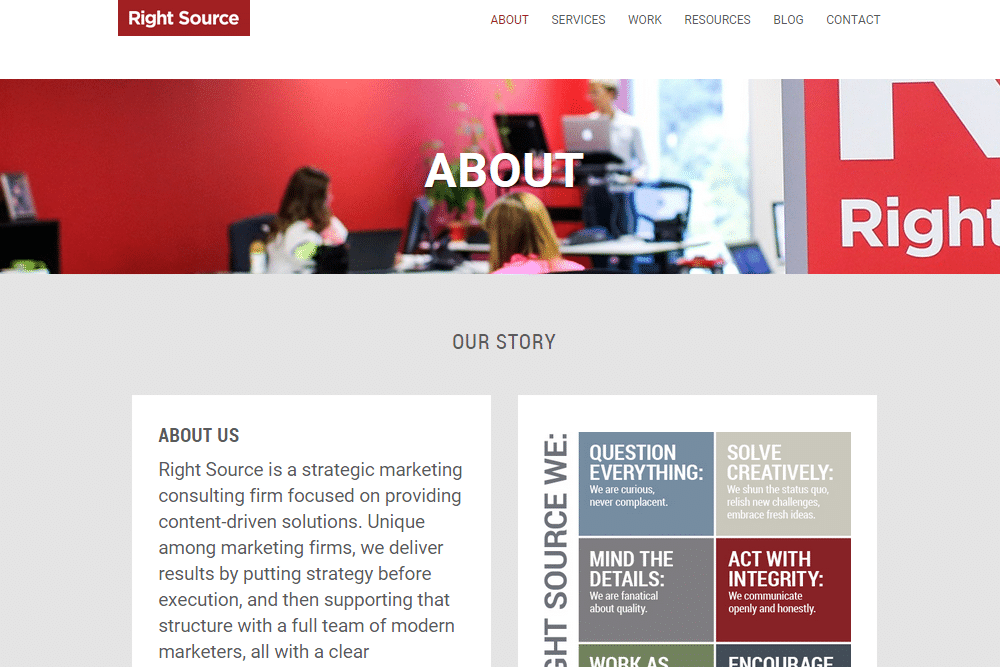
When a company’s website is the foundation of its interactive marketing strategy, that foundation can’t be weak or the house won’t stand. Recently, I’ve talked to a few people who are thinking about building websites for their organizations. While it’s becoming easier to build a website quickly and with minimal technical skills, without some basic knowledge, that foundation is bound to be weak.
Before I knew better, I built a few of these shaky websites myself, and if I weren’t so embarrassed by them, I’d point you to them as examples. Take my word for it: I built bad websites because I didn’t know what I didn’t know, yet forged ahead independently.
Below are the basics I wish I knew then, and now use every day working with Right Source Marketing. If you’re building or redesigning a website, read this primer for help building a site yourself or conversing with whoever is building it for you. If you’re an expert and this bores you, I’d love to hear your additions in the comments section below.
Content Management Systems (or CMS): Gone are the days when only a techie can update a website. Thanks to content management systems such as WordPress, Drupal, Expression Engine and any number of others, anyone can edit a website (yes Dad, if you’re reading this, I mean you, even though you’re not on Facebook or LinkedIn). Make sure your website is built using a CMS so you can edit it quickly, easily, and independently.
Web design vs. web development: A “web designer” isn’t necessarily someone who builds websites. “Web designers” create the look of a website, and “web developers” actually write the code to make it happen. While web designers are often web developers, and vice versa, you might want to split the roles, especially if your project is complex. A web developer who specializes in back-end data systems probably won’t be the right person to create an aesthetically appealing design. A web designer with a graphic design background probably won’t be the right person to build you a complicated custom app. Find the right talent for your specific project.
Analytics: Analytics tell you how many people visited your site, how they got there, and what they did once they were there. To improve your website—and your business—having and using analytics is essential. Make sure you ask your designer or developer to install them, but don’t just leave it at that. Explore your analytics and interpret them to improve your interactive marketing. While there’s a wide range in price and features, Google Analytics is free and can suit most organization’s needs.
Information architecture: Information architecture is a fancy phrase for putting the content on your site where it makes the most sense. Sounds easy, but this can actually be the hardest part of building a website, especially if you’ve got a lot of content. Effective information architecture considers users (visitors to your website) as well as the strategic goals for the site.
Sitemap: Information architecture is often compiled into a sitemap, which is a plot of the structure of the pages on the site. Before the website is launched, this can be a word document, spreadsheet, or collage of papers on the wall (yes, I’ve seen this happen). After the site is launched, the sitemap is a page in a special format that should be submitted to search engines to improve your site’s ranking.

Wireframes: Part design framework, part information architecture, wireframes are a sketch of what you want on your website and where you want it. Wireframes minimize the risk that you’ll design and develop your website only to find out that you don’t have the right information in the right place and need to start all over again. The image to the right could be the beginning of a wireframe for a simple website. Use PowerPoint, one of many free web applications (I used Mockingbird on the sample), or simply a paper and pencil to create your wireframe, just don’t skip this important step.
Search Engine Optimization (SEO): SEO can be a daunting topic for those new to interactive marketing. Google’s algorithm is largely secret and shifts constantly. However, that’s not an excuse to do nothing or just the bare minimum. Simple strategies that make a big difference remain stable. Make sure to ask your website designer or developer to think about SEO when they design your site. Will Davis covers some major SEO misses to watch out for here, or check out a tool like Woorank to point you in the right direction (but don’t take the data it generates for gospel, because sometimes it’s off).
Meta tags: Meta tags are one of those simple things that make a big difference in your website’s SEO ranking. Your pages should all have titles, descriptions, keywords, and alternate text (alt) tags on images. Having a unique title and description for each page is particularly important.
Branded keywords: Many people are satisfied when traffic to their site is only driven by keywords containing their organization’s exact name. Yes, it’s good to show up when people are looking for you, but there are bigger fish. What kind of keywords would people use to search for a business that does what your business does? Brainstorm using common sense to start, then branch out using keyword research tools such as Keyword Spy or Google Adwords. You’ll be amazed at what people actually search for, as shown by the example from Google Adwords below:
Whether or not you are building your website yourself, doing your homework to learn some industry basics will pay dividends in the long run. Feel free to ask questions or add advice in the comments below.
Disclaimer: while Right Source does not do one time website projects often, we frequently help clients build new websites as part of a larger marketing strategy.



